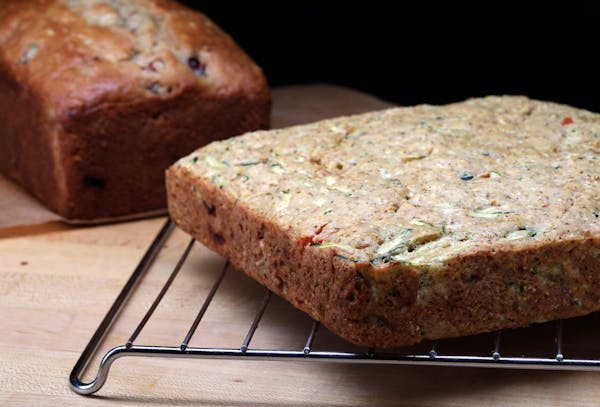Need something easy to add to an otherwise mundane menu? Or something simple to take to a potluck, cookout or other social occasion?
What you need is a good quick bread. They're called quick breads because they're quick to make, at least compared with yeast-risen breads, and they fall halfway between cake and bread. Whether sweet or savory, quick breads can incorporate the best of summer's fruits and vegetables.
Quick breads have a rich history in American foodways. Life changed for home cooks back in 1846, when baking soda — often called saleratus at the time — was marketed, making the first quick breads easy to bake at home. Mixed with acidic soured milk or buttermilk that might otherwise have gone to waste, baking soda created a chemical reaction that made possible the gas bubbles that leaven these breads.
Further innovation came 10 years later, when baking powder, a mixture of a carbonate or bicarbonate and a weak acid (like tartaric acid, for instance), became available. Baking powder leavens without an acidic ingredient, further expanding the home cook's repertoire.
The quick-bread family is big. Its members are baked goods made with leaveners other than yeast. The family includes muffins, biscuits, scones, tea cakes and many other siblings. Cornbread is a quick bread, as is banana bread.
The whole friendly family requires the simplest equipment to prepare. You'll need two bowls — one for dry ingredients, one for wet ingredients — and a wooden spoon or spatula.
Whatever kind of quick bread you're making, take care not to overmix the batter. When you stir the wet ingredients into the dry ones, combine with only 10 to 12 quick strokes. The batter should still show wisps of flour and will be lumpy. Overmixing causes quick breads to deflate after baking, and the baked bread's interior will have tunnels or holes. Stir add-ins such as nuts or cheese into the batter just before putting it into its baking vessel.
Quick breads can bake in loaf pans, square pans or heavy skillets, whatever is easiest. Baking time will vary depending on what you're baking in. Expect a loaf to take an hour or more to bake, while a round or square pan or a skillet-baked bread may take just 30 to 40 minutes. Choose your baking vessel to suit your schedule. Whatever you bake your quick bread in, it should go into a preheated 350-degree oven on the center rack. Start to check if your bread is done about 10 minutes before you expect it to finish.
Quick breads are done when a pick inserted in the middle comes out clean or with a few moist crumbs. It's normal for quick breads baked in loaf pans to have a crack in their tops. Underbaked breads will collapse; overbaked quick breads will be tougher and drier than they should be.
Summer fruits star in a cherry-almond sweet bread that's terrific as a breakfast or afternoon treat. But don't stop there. Substitute any summer fruit for the cherries, change out the nuts and choose a different extract. Try blueberries or blackberries with pistachios and lemon extract, or peaches with pecans and rum extract. Ice it with a simple glaze of powdered sugar and milk if you wish.
Bacon and Cheddar cheese combine in an evergreen favorite quick bread. Our version has a bit of cayenne for a lively lift. Vary it by substituting diced ham for the bacon and shredded Swiss for the Cheddar, or make a vegetarian version with a Mediterranean bent with chopped Kalamata olives and feta.
Zucchini bread is a summer classic, and we have one for you here. But it's not a sweet treat. Ours is a savory version with fresh tomatoes, cornmeal and chile powder. It's a fine accompaniment to a light supper of soup or grilled meat.






